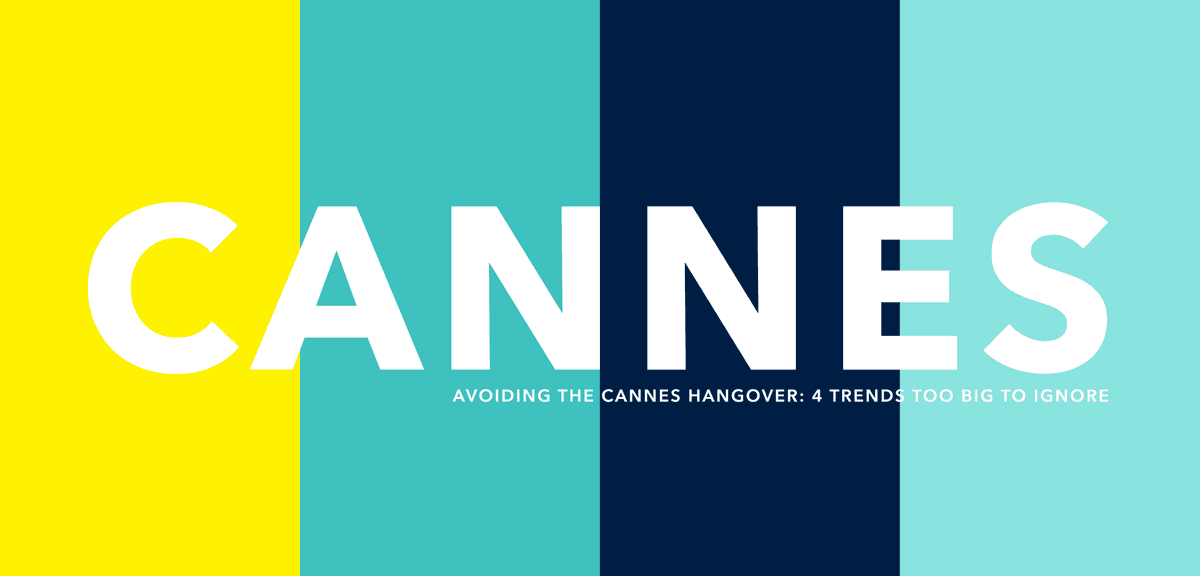Avoiding the Cannes Hangover: 4 Trends Too Big to Ignore
Published on June 29, 2017/Last edited on June 29, 2017/6 min read


Matt McRoberts
SVP, Global Alliances at BrazeWe’re less than a week out from Cannes Lions 2017, and the traditional advertising industry is struggling to come to terms with a painful hangover triggered by tech’s dominant role at this year’s festival. Publicis announced last week that it’ll be skipping Cannes next year and WPP is making noises about doing the same. Meanwhile, tech brands and strategic consultancies were everywhere, with companies like mParticle, Deloitte, Oracle, PwC, and others making the event a major focus.
There’s a big reason for that: the technology side of the customer engagement world is increasingly taking over efforts (and budget) that was previously the exclusive domain of agencies. The shift is being driven by the biggest of the tech giants—including Facebook, Google, and Amazon—which have grown and flourished while traditional advertising brands have shrunk and shed jobs.
As mobile has become the dominant way that customers engage with brands, customer engagement and sustainable business success have increasingly become inseparable from effective digital marketing efforts. But while technology is now an essential part of the marketing landscape, there are still big opportunities for agencies to seize the moment by taking steps to leverage the right technology and the right strategy to help their clients reach their long-term goals.
To get there, agencies need to keep a close eye on the four big trends that emerged from Cannes this year:
1. Product and marketing experiences are merging
Strategic technology consultancies like Deloitte have been steadily making moves on traditional agency business in recent years, using their tech-savvy to sniff out situations where they can catch agencies flat footed and take a bite out of their bottom line. One big factor making this possible is the ongoing blurring of traditional product and marketing experiences in today’s mobile-first world.
Fifty years ago, a rock album was product and the print ad promoting it was marketing. The lines between the two were clear, and agencies’ creative mastery made it possible for them to build up vast client lists and revenue. That’s changed. When you get an in-app message from SoundCloud highlighting a personalized playlist based on your unique engagement patterns within the app, the integrations between product and marketing are so complete that it’s hard to say which one is driving the experience. Agencies that don’t recognize the significance of this tech-driven merger between the two aren’t going to be able to position themselves effectively to own this new, combined experience—and the dollars that come with it.
2. Acquisition is giving way to a focus on retention and engagement
For a long time, most brands looking to invest seriously online—and in the mobile space, in particular—have been so focused on acquisition that they often lose perspective. Acquiring new customers is great, but it’s not an end unto itself, especially when you consider that, on average, 93% of the new app users brands acquire don’t return 30 days after download.
If companies get too caught up in the rat race of customer acquisition without putting together a top-flight engagement and retention strategy, they end up just throwing dollars out the window. That’s already happened to a lot of major enterprise brands, and they’re sick of it. Increasingly, they’re starting to realize that an engagement and retention program that gives customers highly relevant, valuable brand experiences—the kind of experiences that keep users coming back—is a lot more important over the long haul than just continuing to try to fill the top of the funnel. Agencies that think beyond ads and take a holistic view of the relationship between their clients and those clients’ end users are going to be well-positioned to thrive in today’s increasingly retention-focused world.
3. There’s no one dominant channel anymore—it’s about getting them to work together
Once upon a time, it made sense for agencies to put most of their focus on one particular, dominant channel because that was where the consumers were. Think television, back when it was king, or email more recently.
Those days are over. Email is still a powerful way to reach your clients’ customers, but so are push notifications. And web push. And in-browser messages. Plus, new channels—from OTT messaging platforms to Alexa notifications—just keep springing up. The key to success isn’t mastering one particular channel; it’s using technology to understand customer preferences and behaviors, creating targeted audience segments based on that data, then delivering each message across multiple outreach channels, making it possible to leverage all those different gateways for each consumer.
Some customers prefer emails. Others like emails, but would rather hear about a new sale or a new piece of content via push notification. Agencies that can help brands understand, respect, and act on these preferences can unlock a massive amount of value for their clients—and for themselves.
4. At the end of the day, it’s all about that end user
When agencies are looking to focus on understanding and reaching their clients’ customers, a lot of them turn to legacy marketing clouds that pitch themselves as CRM. Now, the term “CRM” has a lot of equity in it—it’s five decades old, represents hundreds of billions of dollars in spending—and there’s no shortage of people beating their chests, saying they’re in the CRM space. But the truth is, most legacy marketing clouds weren’t actually built around the individual end user, the way they claim to be; they’re actually carryovers from enterprise resource planning. And it shows.
These technologies struggle to innovate toward new, dynamic channels and they’ve repeatedly shown that they aren’t capable of providing the kinds of millisecond-fast, deeply personalized brand experiences that today’s customer has come to expect. Agencies that build their customer engagement strategies on the backs of these kinds of aging technologies are at a major competitive disadvantage. They need tools that put the customer and their unique experiences and needs first, and make it possible to provide those end users with brand experiences that speak to them as individuals. That means using marketing technology that’s built to take full advantage of the real-time data collection, targeting, and personalization that mobile and other emerging technologies make possible.
Final thoughts
To survive and thrive in today’s tech-focused world, agencies need to embrace true, customer-focused engagement strategies—and that means having the right tools and tactics at their disposal. If you want to provide your clients with one-to-one customer engagement capabilities in real-time, it’s time to explore Appboy Accelerator, Appboy’s enablement program for agencies and consultancies.
For more on how agencies and consultancies can help their clients respond to today’s fast-changing landscape, sign up to receive the inaugural issue of Appboy’s Accelerator magazine.
Be Absolutely Engaging.™
Sign up for regular updates from Braze.
Related Content
View the Blog
A day in the life of a data scientist on the BrazeAIᵀᴹ forward-deployed engineering team

McKay Jensen

The new inbox reality: How iOS changes are reshaping email marketing

Aparna Prasad

Experience optimization: Turning data insights into better journeys
